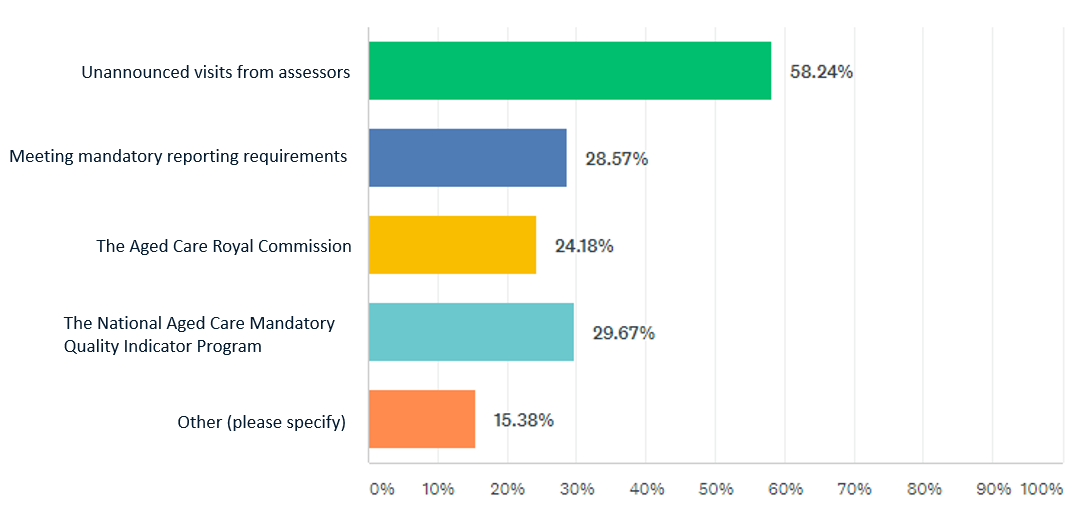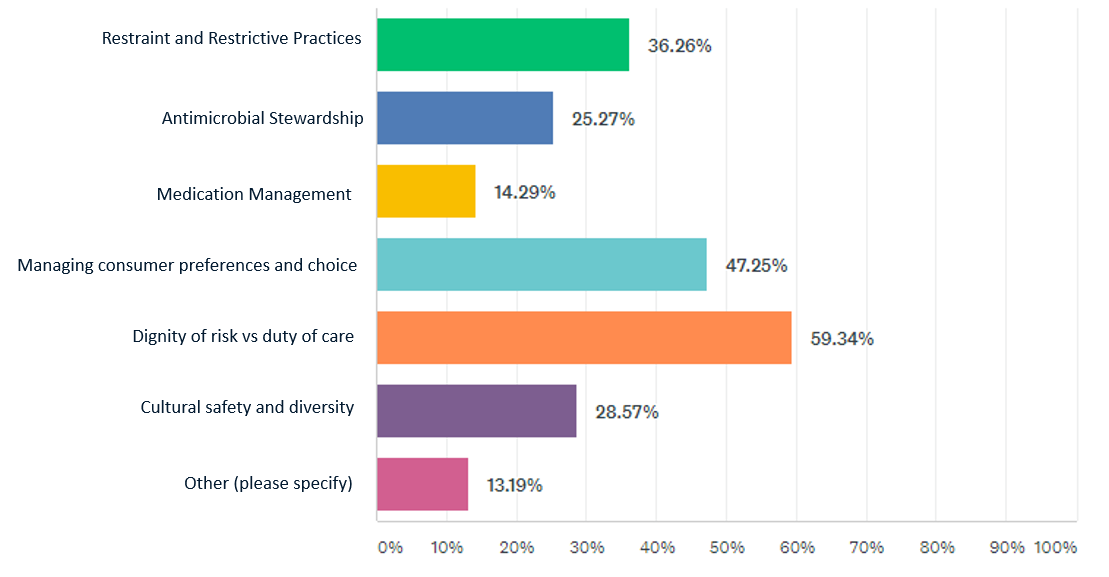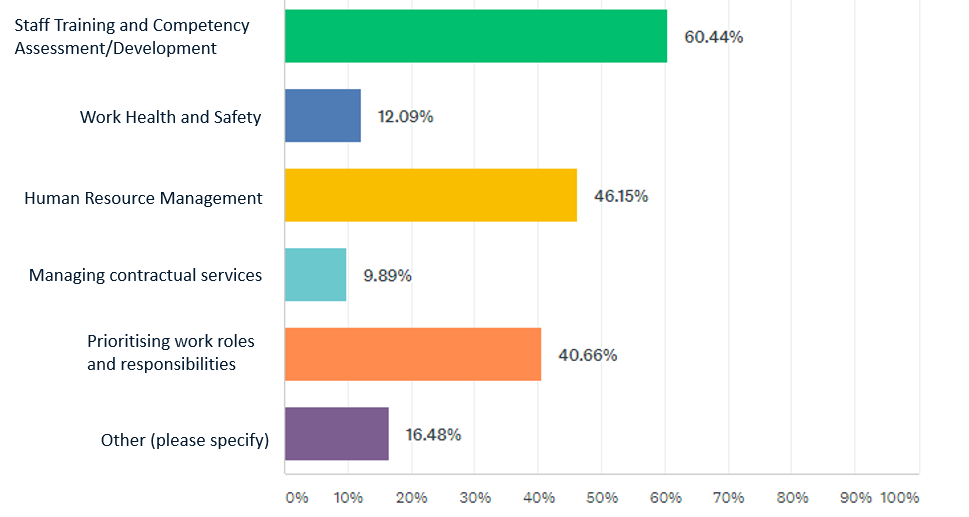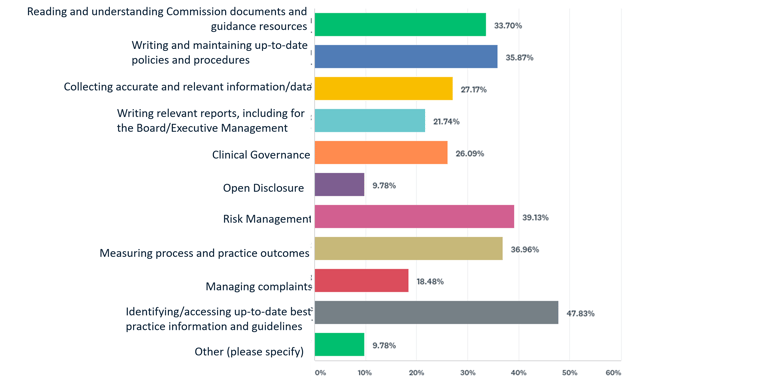The Royal Commission into Aged Care Quality and Safety (Aged Care Royal Commission) triggered a substantial overhaul of the regulatory standards in aged care and undoubtedly forced aged care providers to evaluate the adequacy of their existing governance, risk and compliance (GRC) frameworks.
Aged Care Essentials (ACE) was created to help aged care providers navigate the dynamic and increasingly demanding legal and regulatory landscape of the aged care industry. But assistance is only useful to the extent that it is relevant to our audience.
Our recent survey was conducted to better understand the information needs of our audience, and how we could support them with our ACE content. The survey was designed to ascertain the:
- demographics of our audience
- existing levels of understanding in key areas of GRC, and
- main challenges and concerns with respect to GRC.
Overall, we found that aged care providers across Australia are struggling to meet the same challenges. So, if you are daunted by the prospect of unannounced site visits, concerned about staff training and uncertain about how to demonstrate compliance, these survey results will hopefully reassure you that you are not alone.
Who Responded to the Survey?
The survey was anonymous, and we had nearly 100 responses from subscribers in New South Wales, Victoria and Queensland. Approximately 92 per cent of respondents were from residential aged care facilities, with 82 per cent in managerial roles and 25 per cent in clinical roles (with some respondents performing both roles). About half of all respondents (56 per cent) worked in homes with 0-99 beds, while 26 per cent worked in homes with 100-149 beds, and 14 per cent in homes with more than 150 beds.
Levels of Understanding
The aim of the first part of the survey was to gauge the base level of understanding in certain areas among our respondents. Across all states and topic areas the results indicated that most respondents had a reasonable level of understanding but wanted to broaden it. There was no correlation between the level of understanding and the respondent’s organisational role.
Most respondents indicated a reasonable to excellent level of understanding of the Aged Care Quality Standards (the Standards) in terms of knowing what the Standards are, what the requirements say, and what their corresponding roles and responsibilities are under the Standards.
However, most respondents also indicated that they needed or wanted more information to broaden their understanding of certain issues. The top five of these issues are as follows (with percentages indicating the proportion of respondents who wanted or needed to know more about the issue):
- How to show assessors that we meet the Standards (80%)
- How to use the self-assessment tool (77%)
- How to meet the requirements (72%)
- How the requirements interrelate (72%)
- The requirements under the Standards (70%)
This suggests a commitment within the industry to meet the new Standards, alongside an uncertainty about how to do it. Respondents know what the Standards say but aren’t sure whether their understanding is consistent with what assessors are looking for. Even those who are confident about what they need to do aren’t confident about how to demonstrate that they’ve done it. In other words, when it comes to compliance with the Standards, many providers understand the ‘what’ but not the ‘how’.
Challenges and Concerns
The second part of our survey focused on the most prominent challenges and concerns among our respondents. In the Figures below, percentages indicate the proportion of respondents who considered the issue to be a “main challenge or concern.”
Figure 1: challenges and concerns involving assessment and providers' legal obligations
Figure 1 indicates a strong concern about unannounced visits from assessors. One respondent likened unannounced site visits to “raids normally conducted for criminals”. Given the uncertainty about assessors’ expectations and how providers can achieve a “met” score, stress from unannounced visits seems almost inevitable.
Figure 2: challenges and concerns involving consumer care
Figure 2 groups together issues related to consumer care. The top two concerns (“Managing consumer preferences and choice” and “Dignity of risk vs duty of care”) are directly linked with requirements under Standard 1: Consumer Dignity and Choice.
Figure 3: challenges and concerns involving staff
There appears to be a correlation between the top concerns in Figures 2 and 3, which is consistent with anecdotal evidence presented to the Aged Care Royal Commission. Figure 2 indicates that the increasing focus on consumer dignity and choice presents a major challenge to providers, while Figure 3 indicates that providers are concerned about training and assessing staff.
Considered together, these factors suggest that providers are struggling to employ and retain enough staff who understand consumer-focused care and are adequately skilled and qualified to implement it. It may also indicate that the recent introduction of the Standards has increased workloads, demanded new skills and put pressure on staff generally. And these challenges may be compounded by the tension between giving consumers the dignity of risk while also complying with the duty of care to the consumer.
Figure 4: challenges and concerns involving governance
The main theme emerging from Figure 4 is that providers want guidance and are having trouble finding it. This is not surprising given the huge size and complexity of the Standards and the overwhelming and confusing abundance of information provided by the Aged Care Quality and Safety Commission, Department of Health and the Aged Care Royal Commission.
How Do These Findings Match-Up with the Commission’s Recent Webinar Survey?
On 4 November 2019, the Aged Care Quality and Safety Commission (the Commission) held a webinar on “Accountabilities of governing bodies in aged care”. During the webinar, the panel conducted a survey about Standard 8(3)(c). That Standard requires providers to demonstrate effective organisation wide governance systems relating to:
- information management
- continuous improvement
- financial governance
- workforce governance, including the assignment of clear responsibilities and accountabilities
- regulatory compliance
- feedback and complaints
The survey asked, “which of these governance systems do you feel least confident about?” These were the results, with percentages indicating the proportion of respondents who feel least confident about this issue:
- Workforce Governance (37%)
- Information Management (23%)
- Financial Governance (21%)
- Regulatory Compliance (11%)
- Feedback and Complaints (9%)
- Continuous Improvement (8%)
The placement of “Workforce Governance” at the top of this list is consistent with our findings and brings into sharper outline a picture of the aged care industry. That picture shows us that providers’ major concerns all relate to staff – in particular, the capacity of staff to understand and put into practice the things they need to do to meet the Standards and pass assessments.
Conclusion
If there’s one thing to take away from the results of our survey, it’s that you are not alone – other providers are being kept up at night by the same challenges that trouble you. This includes the challenge of somehow cutting through an overwhelming abundance of information to find the up-to-date guidance that you need.
The goal of ACE is to help you meet that challenge.
The responses to our survey have given us valuable insights into the kinds of content that are relevant and useful to you. We would like to thank all respondents for giving their time and helping to make the survey a success.
We intend to address the issues raised in future articles, so stay tuned!
Missed out on the survey, but would like to share your thoughts and insights? Click here.








